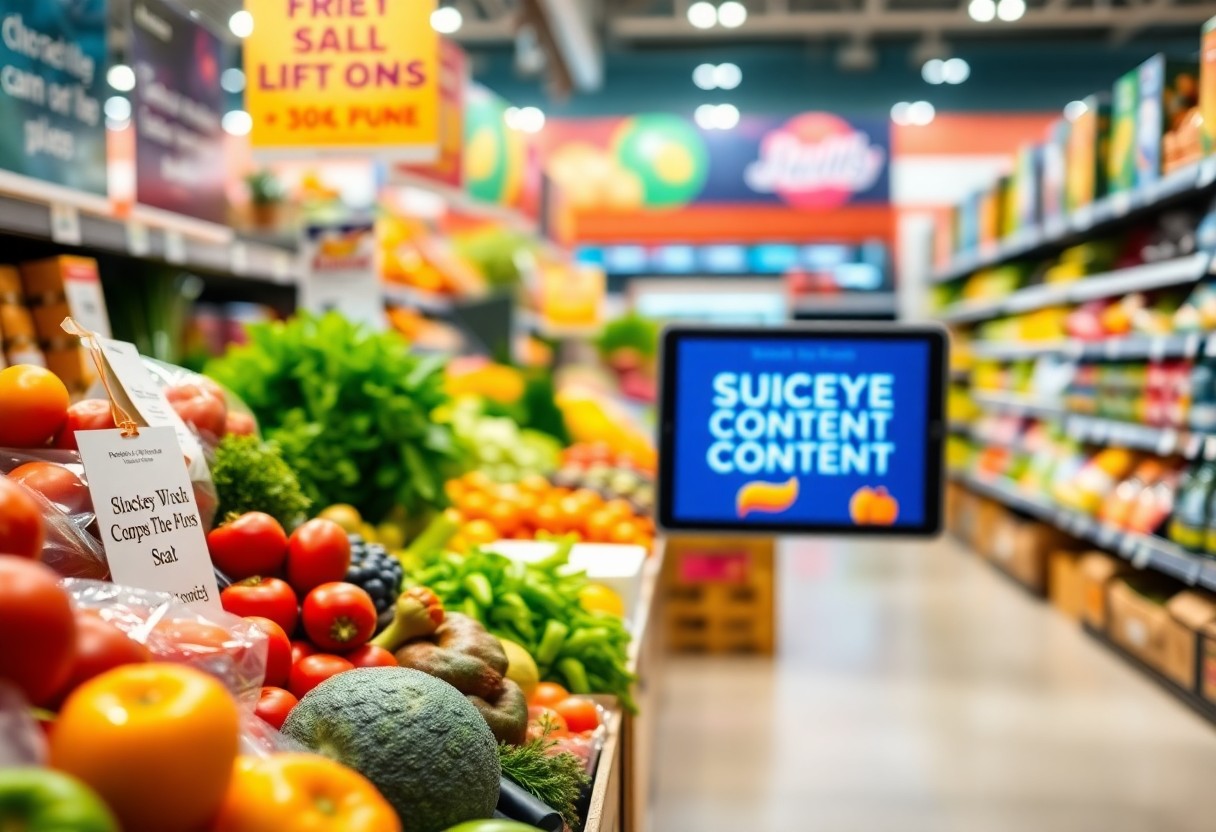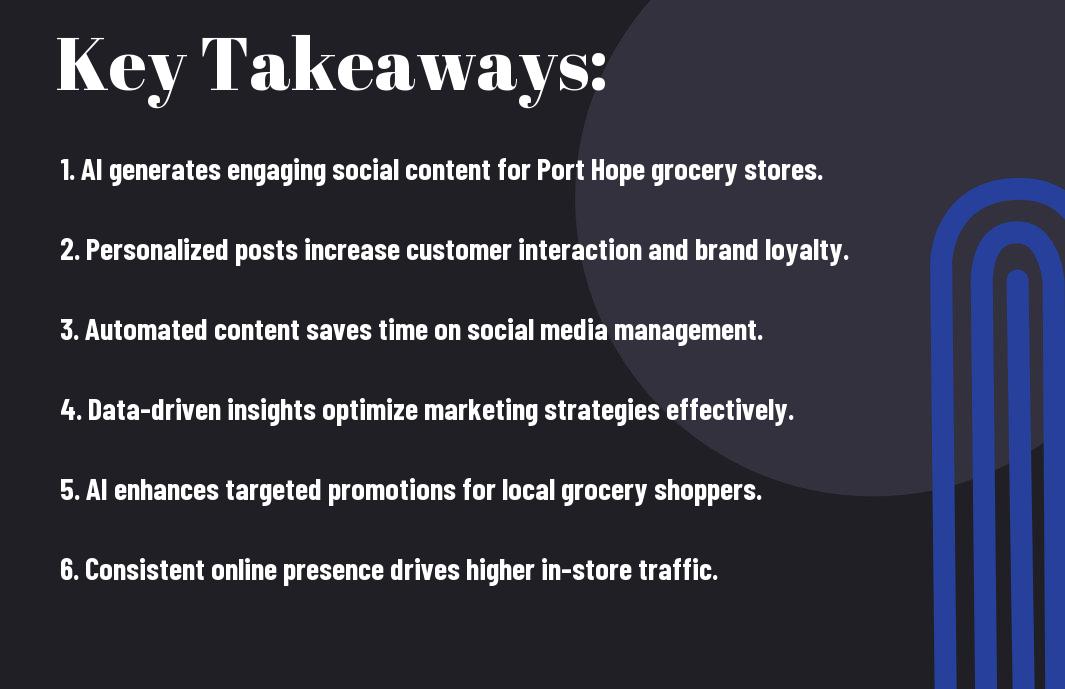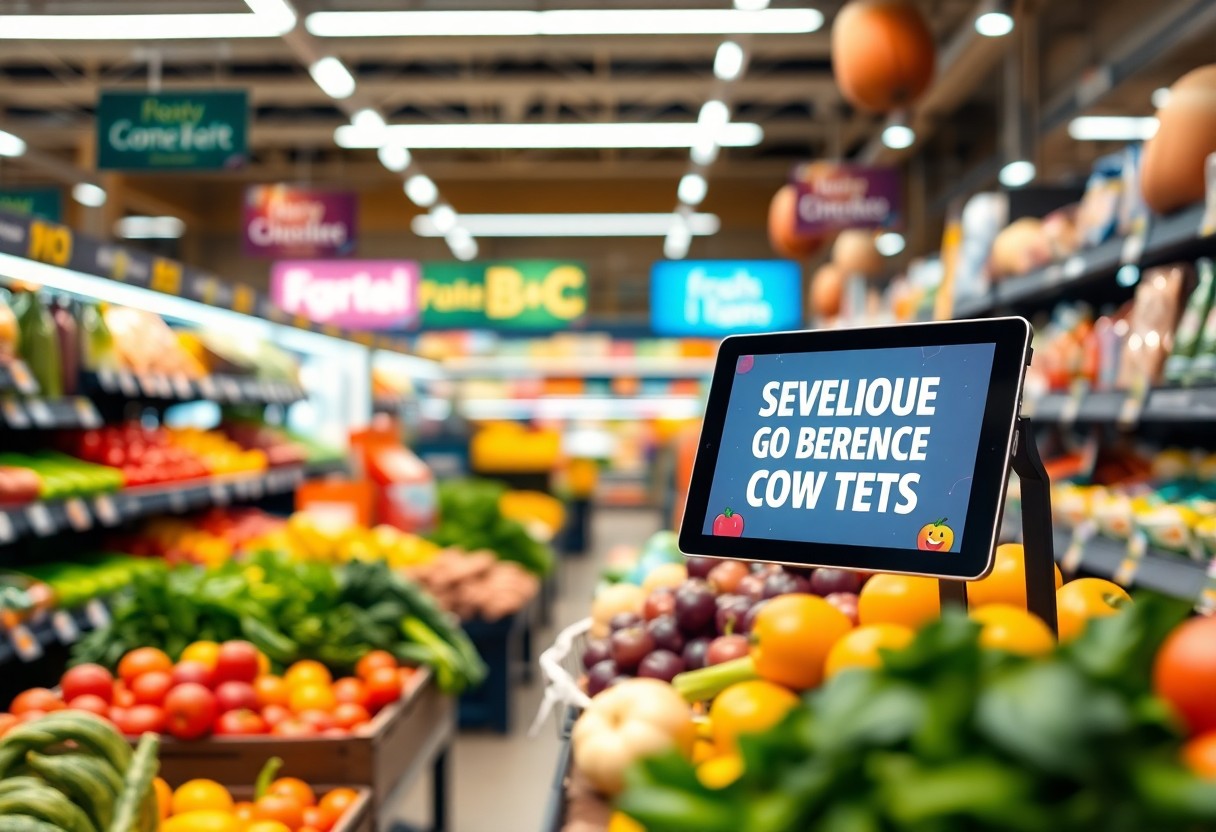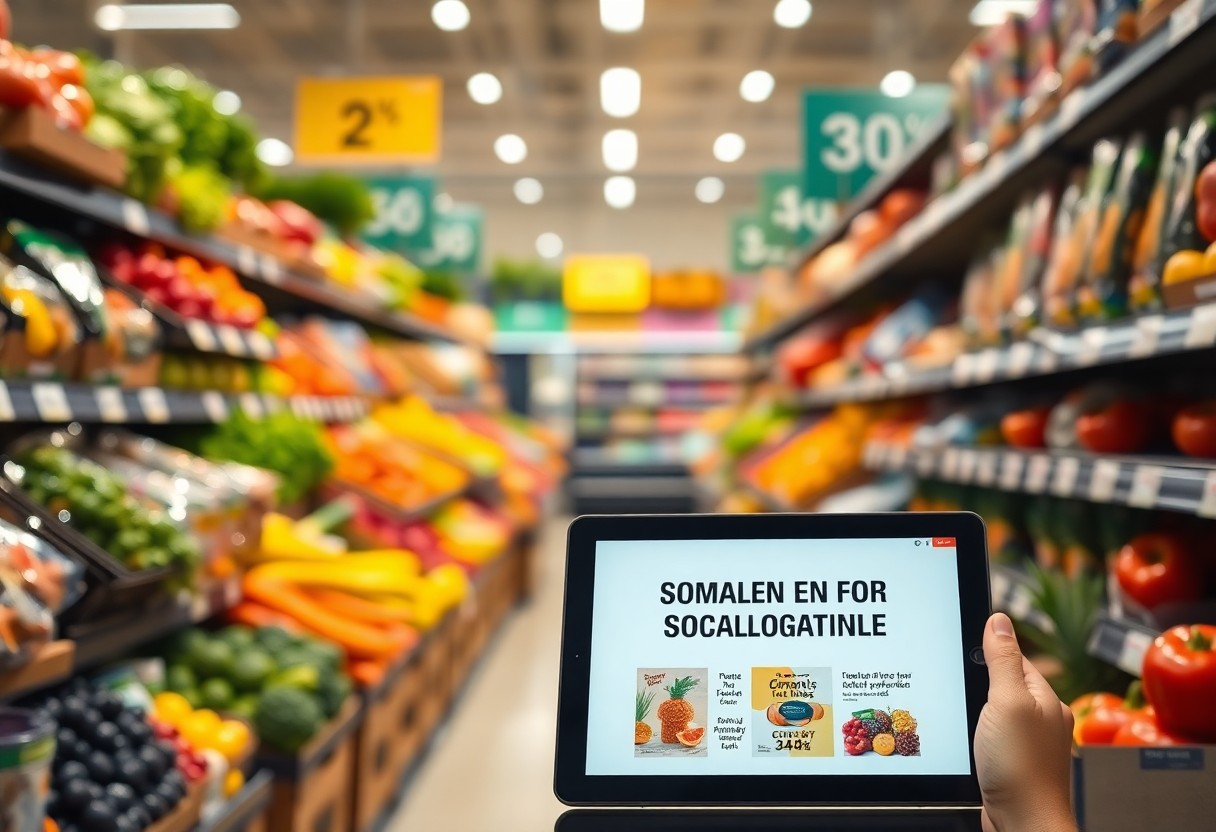It’s important for you to harness the power of AI-created social content to elevate your Port Hope grocery store’s marketing strategy. By integrating artificial intelligence, you can create engaging posts that showcase your products and promotions, driving customer interest and sales growth. This innovative approach not only helps you connect with your audience but also improves your store’s visibility on social media platforms. Embracing AI technology puts you ahead of the competition, ensuring your grocery store thrives in the digital landscape.

Key Takeaways:
- AI-generated social content can enhance customer engagement by personalizing promotions and targeting specific demographics effectively.
- Utilizing data analytics allows grocery stores to understand consumer behavior better, leading to more informed marketing strategies and increased sales.
- Implementing AI tools for content creation not only streamlines marketing processes but also helps maintain consistent brand messaging across various platforms.
Understanding AI in Retail
Your interest in leveraging technology to enhance your grocery store’s performance is both timely and necessary. As the retail landscape evolves, businesses like yours are increasingly turning to artificial intelligence (AI) to optimize operations and engage customers more effectively. AI facilitates data analysis, customer interaction, and inventory management, ensuring you’re not just keeping up with trends but staying ahead of the curve. By delving into the nuances of AI in retail, you gain insights that can directly improve your grocery store’s bottom line. For more in-depth strategies, consider exploring How generative AI can boost consumer marketing.
The Role of AI in Grocery Stores
Grocery stores, more than ever, are becoming intricate ecosystems where customer preferences and purchasing patterns dictate inventory and marketing strategies. AI tools help analyze vast amounts of consumer data, allowing you to monitor buying behaviors and predict future trends accurately. By implementing AI-driven analytics, you can fine-tune your stock levels, ensuring that popular items are always available while minimizing waste due to overstock. This predictive capability allows you to align your inventory with your customer’s needs—an invaluable asset in today’s competitive market.
Furthermore, AI technology can serve as your virtual assistant when it comes to marketing strategies. Personalized promotions and targeted advertising initiatives can be generated using AI algorithms that understand your customer segments better than ever. Imagine the potential of creating tailored offers that resonate with your audience, enhancing customer loyalty and driving repeat business. From automating your social media posts to crafting engaging content that speaks directly to your customer base, AI can substantially improve your marketing efficacy.
The integration of AI in grocery stores doesn’t stop at consumer interaction; it also plays a pivotal role in optimizing your overall operations. Inventory management, customer service, and supply chain logistics can be streamlined through AI processes. For example, chatbots can enhance customer engagement by providing instant responses to inquiries, while advanced algorithms can optimize your supply chain, ensuring that products are delivered at the right time, minimizing disruptions. In short, the role of AI is transformative, turning grocery stores into more efficient and customer-focused operations.
Benefits of AI-Generated Content
Across the retail sector, AI-generated content offers remarkable benefits that can dramatically elevate your grocery store’s marketing efforts. The ability to quickly generate engaging and relevant content allows you to maintain a dynamic online presence without the hefty time investment usually required. By utilizing AI for content creation, you can focus on strategic initiatives while letting technology handle the repetitive tasks, such as social media updates or newsletter drafts. This results in a more cohesive branding strategy that reflects your store’s unique voice and style.
Moreover, AI-generated content allows for real-time engagement with your audience, adapting to trends and customer feedback almost instantaneously. The flexibility of AI-driven tools empowers you to create and distribute customized messaging tailored to specific customer segments, thus enhancing the likelihood of conversion. Such personalized marketing strategies not only drive customer engagement but also foster a sense of community around your grocery store. By consistently delivering value through relevant content, you establish a stronger connection with your audience, ultimately leading to increased sales.
It’s important to note that while AI-generated content is incredibly beneficial, there are also potential pitfalls to be mindful of. Inadequate oversight could lead to messages that stray from your brand identity or fail to resonate with your customer base, which can be damaging. Therefore, maintaining a balance between automated content and human oversight is necessary. The exciting part is that with the right strategies in place, AI can amplify your grocery store’s marketing precision and customer outreach, positioning you for greater success in an increasingly competitive landscape.

Strategies for Implementing AI-Created Content
While the potential of AI-created content in driving sales for Port Hope grocery stores is undeniable, successfully implementing these strategies calls for a structured approach. The first step involves understanding how to integrate AI technologies into your content creation processes. This means leveraging AI tools to analyze customer behavior, preferences, and trends, which will inform your content strategy. By utilizing such data, you can tailor your messaging to better resonate with your target audience, significantly boosting engagement and conversion rates. In addition, this approach can save you time and resources by automating routine content creation tasks.
Moreover, measuring the performance of your AI-generated content is important. Utilizing analytics tools will allow you to gain insights into what type of content performs best among your customers. This data-driven strategy can help you continuously refine your approach, ensuring that the content you produce meets evolving customer expectations and demands. You can then showcase your grocery store’s unique offerings or promotions in an engaging manner, leading to increased foot traffic and sales in your business. Thus, implementing AI-created content isn’t merely about technology but revolves around incorporating it into your overall marketing strategy.
Finally, successful implementation of AI-created content also requires ongoing evaluation and adjustment. As consumer preferences shift, your content must also adapt accordingly. Keeping an eye on industry trends, competitor activities, and social media interactions will provide you with the context needed to evolve your content strategy effectively. This continual learning process not only ensures that you remain relevant but also fosters a deeper connection with your audience, solidifying their loyalty to your grocery store.
Identifying Target Audiences
Below are key components to help you identify your target audience more effectively:
| Components | Description |
|---|---|
| Demographics | Analyze age, gender, income level, etc. |
| Interests | Explore hobbies and lifestyle preferences. |
| Shopping Behavior | Understand purchasing habits and preferences. |
| Local Trends | Adjust your marketing to reflect community interests. |
| Customer Feedback | Utilize surveys and reviews to gauge satisfaction. |
This targeted approach allows you to tailor your content and marketing strategies, ensuring you’re not only reaching but also authentically engaging with your audience. Delving into areas such as demographics, interests, shopping behaviors, local trends, and customer feedback will reveal patterns and preferences that are important for successfully reaching your potential customers. All this information can inform the development of AI-generated content that speaks directly to the needs and desires of your target audience.
Types of Content to Create
Due to the rapidly shifting landscape of grocery shopping patterns, it’s vital to leverage AI to generate various types of content that can drive customer engagement. Here are several effective content types you might consider creating:
| Content Type | Description |
|---|---|
| Social Media Posts | Engage audiences with attractive images and promotions. |
| Blog Articles | Provide tips on healthy eating and recipe ideas. |
| Email Newsletters | Share special offers and new product arrivals. |
| Interactive Content | Encourage customer participation through polls & quizzes. |
| Videos and Tutorials | Showcase product demonstrations or cooking lessons. |
By exploring these diverse content types, you can create a multifaceted approach that speaks to various customer segments effectively. Utilizing AI to streamline this creative process allows you to maintain consistency while ensuring each piece resonates with your audience. Whether it’s engaging social media posts, informative blog articles, captivating email newsletters, or interactive content like polls and quizzes, the potential for customer engagement is significant. Recognizing the opportunities these varied formats provide can lead to a healthier relationship with your customers and ultimately drive more sales for your grocery store.
Case Studies: Success Stories from Port Hope
For businesses in Port Hope, leveraging AI-generated social content has resulted in transformative growth and enhanced customer connectivity. You’ll find that various local grocery stores have successfully implemented these initiatives, leading to measurable improvements in both sales and customer engagement. Here’s a detailed examination of some impressive case studies from the area:
- Market Fresh: Experienced a remarkable 35% increase in monthly sales after integrating AI-curated social media posts that highlight weekly specials and community events.
- Port Hope Food Mart: Their brand awareness surged, with a 50% rise in social media followers, largely attributed to personalized content designed specifically for the local demographic.
- Green Grocer: Found that targeting specific customer interests through AI-driven posts led to a 20% boost in customer foot traffic during promotional weeks.
- Organic Corner: Achieved a 40% increase in online engagement rates, with posts featuring user-generated content and community highlights resonating well with their audience.
These success stories underline the power of AI in creating customized content that not only resonates with customers but also drives tangible business results. As you consider how to implement similar strategies, it’s necessary to evaluate how these trending practices can fit within your own grocery store. Engaging storytelling, showcasing local produce, and highlighting community involvement are elements you should integrate into your digital marketing efforts for optimum results.
Local Grocery Store Initiatives
Grocery stores in Port Hope have taken proactive steps to incorporate technology-driven strategies that align with consumer preferences. By utilizing AI-generated social content, you can create personalized experiences that connect with your audience on a deeper level. One approach is to focus on local produce and seasonal availability, which can not only captivate customer interest but also foster loyalty to your store. This strategy enhances the shopping experience and promotes community engagement, making shoppers feel more involved in their local economy.
In addition to focusing on local produce, you may also consider running social media campaigns that engage the community, such as cooking contests or sustainability initiatives. By involving your customers in interactive events, it encourages them to share their experiences online, creating a buzz that leads to increased visibility for your store. Through this AI-driven content, you’re effectively blending marketing and community involvement, resulting in a symbiotic relationship that drives traffic to your grocery store.
Moreover, the personal touch of storytelling in social media posts plays a significant role in your initiatives. By sharing the origins of your products, the farmers behind them, or the journey of your food from farm to table, you create a narrative that resonates with your audience. As you implement these online initiatives, remember to gather feedback and adapt your strategies based on community engagement and response to maximize impact.
Impact on Sales and Customer Engagement
Across the board, grocery stores in Port Hope have seen a significant uptick in both sales and customer engagement metrics due to their innovative use of AI-generated social content. The incorporation of tailored content not only makes your marketing more effective but also strengthens your relationship with customers, creating a loyal customer base. Enhanced visual storytelling can improve audience retention on social media platforms and leads to more customers coming through the door, eager to experience what your store has to offer.
For instance, one local grocery store reported that engagement rates on social platforms rose by 75% after implementing AI-driven posts that highlighted unique selling points such as exclusive deals or profiles on local suppliers. Additionally, they noted a 30% increase in average transaction values as customers were more informed and excited about their purchases. The positive correlation between effective content and customer spending showcases the importance of aligning marketing strategies with customer preferences.
As you explore the potential of AI-generated content, it’s necessary to pay attention to your data analytics. Monitor how your engagement translates to sales figures, and make adjustments as necessary. Other stores have benefited from incorporating customer feedback into their AI content strategies, resulting in higher conversion rates and more effective promotional campaigns.

Overcoming Challenges in AI Adoption
All grocery store owners in Port Hope are aware that AI technology can significantly enhance your marketing efforts, especially through social media channels. However, adopting this innovative technology is not without its challenges. One primary concern is technical barriers that may prevent you from leveraging AI effectively. These can include integration issues with existing systems, data management problems, and the complexity of the technology itself. You can learn more about how to navigate the social media landscape by checking out Social Media for Grocery Stores: 6 Tips for Growing Social. To truly benefit from AI in your grocery store, it is imperative to have a solid understanding of digital infrastructure and how AI tools can fit into your current operations.
Technical Barriers and Solutions
Before you can fully integrate AI into your grocery store operations, you must address foundational technical barriers. Start by ensuring that your existing systems are compatible with modern AI solutions. This may involve upgrading software or hardware, which might seem daunting. It’s advisable to consult with IT professionals who have experience in grocery retail to identify these gaps. Opt for AI tools designed for user-friendliness and ease of integration. Many software providers offer APIs that facilitate connections to existing systems, simplifying the transition and reducing potential downtime.
Moreover, a significant technical barrier you might encounter is the management of large datasets. AI thrives on data; therefore, having a robust data management system in place that can collect, store, and analyze customer information is imperative. You should consider investing in cloud-based solutions, which can provide you with the flexibility and scalability necessary for dealing with fluctuating data volumes. Engaging a data analyst can also help optimize this valuable information, allowing AI algorithms to deliver more accurate recommendations and content tailored to your customers.
Staff Training and Adaptation
Around the implementation of AI technology, the training and adaptation of your staff can be another significant challenge. Your employees may feel intimidated or resistant to using new systems, which can hinder the implementation of AI solutions. To promote a smooth transition, it’s vital to develop a comprehensive training program that familiarizes your team with the new technology. Focus on hands-on training sessions where employees can experiment with AI tools in a controlled environment, gradually building their confidence.
In addition to formal training programs, you can encourage a culture of learning and curiosity. Promote open discussions where employees feel comfortable asking questions and sharing their experiences with the AI tools. Celebrating small milestones and achievements can also boost morale and foster a sense of teamwork as everyone adapts to the new technology. To enhance your employees’ engagement, consider offering incentives for those who successfully utilize AI tools in their daily tasks.
Technical issues surrounding staff adaptation should not be overlooked. As your grocery store embraces AI and evolves its marketing strategies, investing in ongoing education and support for your employees is imperative. Whether through additional workshops, webinars, or partnerships with AI vendors offering user support, providing continuous learning opportunities will empower your team to use technology effectively. Understanding that your staff plays a vital role in executing AI-driven strategies will significantly enhance not only their skills but also improve overall customer experience in your store.
Measuring Success: Tracking Sales Growth
After implementing AI-created social content into your Port Hope grocery store’s marketing strategy, it is imperative to evaluate how this approach translates into actual sales growth. Tracking your sales growth over time can provide invaluable insights into what works and what doesn’t. To achieve this, you’ll need to establish a systematic approach to measuring progress against your predetermined benchmarks. This involves not only examining sales figures, but also understanding the broader implications of customer engagement and brand visibility that AI-driven content can influence.
Key Performance Indicators (KPIs)
Below, you’ll find a selection of Key Performance Indicators (KPIs) that can help you gauge the effectiveness of your AI-driven social media strategy. First and foremost, monitor your overall sales revenue before and after implementing AI-created content. A clear increase in sales numbers will be a good indicator of the strategy’s success. Furthermore, analyze specific product sales to discern if certain AI-generated posts lead to heightened sales of targeted items. By digging deeper into these statistics, you can identify which products resonate with your audience and adjust your inventory or promotional strategies accordingly.
In addition to direct sales figures, consider monitoring your customer engagement metrics such as likes, shares, and comments on your social media posts. These metrics provide insights into how well your AI-generated content connects with your audience. A noticeable uptick in interaction can correlate with increased foot traffic in your store, ultimately leading to higher sales figures. You may also want to track website traffic and conversions, analyzing how visitors interact with your content and whether they make purchases following their online engagement.
Lastly, don’t overlook customer retention rates as a significant KPI. Tracking repeat customers will give you insight into the long-term impact of your marketing efforts. If your AI content is effective, you should see an increase in this metric, which indicates that customers are not only being attracted but are also returning for more purchases. By continuously analyzing these KPIs, you will have a comprehensive view of your sales growth trajectory and make informed decisions that propel your grocery store forward.
Tools for Measurement
Any marketing strategy benefits immensely from using analytical tools to measure its effectiveness. To track your sales growth effectively, consider integrating tools such as Google Analytics and social media insights. These platforms provide detailed reporting on various metrics, allowing you to see trends over time and how they relate to your AI-created content. For instance, Google Analytics can show you how changes in your website traffic coincide with specific marketing campaigns, providing a direct link between advertising efforts and sales performance.
Utilizing customer relationship management (CRM) systems can further enrich your analysis. These systems gather data about customer interactions, helping you examine their purchasing behaviors, preferences, and feedback. You can segment your customer base according to various criteria, enabling you to tailor future AI-generated content according to what resonates with specific customer groups. Additionally, platforms like Hootsuite or Buffer offer advanced analytics for social media content, presenting insights on engagement levels that can help refine your strategies even further.
Due to the variety of tools available, selecting the right measurement tools is imperative for accurately gauging the success of your marketing initiatives. Each platform you choose should align with your specific business goals and provide data that you can easily interpret to inform your next steps. Combining insights from these tools allows you to create a well-rounded view of your performance, offering a foundation for strategic adjustments that enhance your sales trajectory.
Future Trends in AI and Grocery Retail
Keep an eye on the rapid advancements in AI technologies that are reshaping the grocery retail landscape. The integration of AI into grocery stores has already transformed how you shop, and this evolution is set to accelerate. Grocery stores are now utilizing AI for inventory management and customer service, leading to a more efficient shopping experience for you. With machine learning algorithms analyzing vast amounts of data, grocery stores can predict consumer behavior and personalize marketing strategies effectively. This means not only more relevant promotions for you but also improved stock availability, ensuring that your favorite products are always on the shelves. As these AI technologies continue to evolve, you can expect an increasingly tailored shopping experience that caters specifically to your preferences and buying habits.
Evolving AI Technologies
Beside enhancing shopping experiences, new AI technologies such as voice recognition, advanced analytics, and chatbots are streamlining operations in ways you may not even notice. Voice-activated shopping lists and AI-powered virtual assistants are becoming commonplace, allowing you to engage with your grocery shopping in a whole new way. Imagine asking your AI assistant for recipe suggestions and instantly receiving a list of ingredients that you can add to your online cart for delivery. This innovative technology is not only convenient but helps you make informed purchasing decisions based on nutritional information and comparative pricing, effectively simplifying your grocery shopping process.
Furthermore, technology such as computer vision is making its way into grocery stores, enabling better tracking of product quality. With capabilities that allow for facial recognition and shelf monitoring, you’ll find that grocery stores are now getting smarter about managing inventory. This technology can alert staff when items are running low or nearing expiry, significantly reducing food waste and ensuring that you always receive fresh products. AI is also assisting in creating dynamic pricing models that adjust based on demand, ensuring that you get the best possible price while maximizing profits for the store.
Predictions for Grocery Store Strategies
Grocery stores are expected to embrace AI fully, leading to innovative strategies that cater specifically to you as a consumer. Grocery stores will likely focus on enhancing loyalty programs driven by AI, which can analyze your shopping patterns and rewards preferences. By doing this, they can offer you personalized discounts rooted in your buying history. Moreover, expect to see more immersive shopping experiences using augmented reality and AI-driven simulations that facilitate an engaging environment for you in-store. This integration will not only significantly enhance your shopping experience but also drive sales effectively.
To maximize their sales potential, grocery retailers will increasingly turn to AI analytics, interpreting data to engineer strategies that resonate with your unique preferences. You will likely see personalized product recommendations not just online but also in-store, tailored to your previous purchases and dietary preferences. With major retailers investing in AI, competition will drive continuous improvement in customer engagement practices, leading to enriched experiences whenever you shop. This future will not only redefine your grocery shopping experience but will also promote sustainability and efficiency across the industry, ensuring that the benefits extend far beyond the checkout line.
Final Words
With these considerations, it’s evident that leveraging AI-created social content can significantly enhance your grocery store’s engagement and drive sales. In today’s competitive landscape, it is imperative to adopt innovative strategies to stay ahead. By integrating AI tools into your social media marketing efforts, you position yourself not only to create compelling content but also to tailor this content to meet the specific preferences of your target audience. This tailored approach not only boosts customer interaction but also fosters brand loyalty, making your grocery store a go-to choice within the community.
Your understanding of consumer behavior can be amplified by harnessing data analytics through AI. This technology can analyze trends and preferences, allowing you to develop more engaging posts that resonate with your audience. By focusing on relevant themes and trending topics, you can capture the attention of potential customers, driving traffic to your store. The convenience of AI in creating and scheduling social media content means you can maintain a consistent online presence while freeing up valuable time for other imperative aspects of your business. As you explore these tools, you may find valuable insights into how to optimize your social media channels effectively.
Embracing AI-created social content does not merely position you to keep pace with industry changes; it equips you to proactively shape your marketing strategy. As your grocery store seeks to adapt to the transforming landscape, particularly highlighted in The future of grocery retail, being at the forefront of technological advancements is imperative. By investing in AI-driven content strategies, you empower your brand to flourish and respond dynamically to consumer shifts. In the end, weaving together effective social media practices with advanced technology will not only enhance your presence but will also drive measurable growth in your sales figures.
FAQ
Q: How can AI-generated content help Port Hope grocery stores increase sales?
A: AI-generated content can assist Port Hope grocery stores by creating engaging social media posts that showcase products, promotions, and events. By utilizing data-driven insights, stores can tailor their content to resonate with local customers, encouraging more foot traffic and higher sales. Additionally, timely and relevant posts can help keep the store at the forefront of customers’ minds.
Q: What types of content can AI create for grocery stores?
A: AI can generate various types of content for grocery stores, including promotional graphics, product descriptions, social media posts, and blog articles. This content can highlight daily specials, seasonal products, healthy recipes, or community-based events. The adaptability of AI allows stores to create content that appeals to their unique audience and encourages them to engage with the brand.
Q: Is it expensive to implement AI-generated content in grocery store marketing?
A: The cost of implementing AI-generated content can vary depending on the tools and services chosen. Many AI platforms offer scalable solutions that can fit various budgets. While there may be an initial investment in software or services, the potential for increased customer engagement and sales often outweighs the cost, making it a worthwhile option for many grocery stores.
Q: How can grocery stores ensure that their AI-generated content is relevant to their audience?
A: Grocery stores can ensure that AI-generated content is relevant by analyzing customer data and purchasing patterns. By understanding the interests and preferences of their local customer base, stores can guide the AI tools to create personalized content. Engaging with customers through surveys or feedback can also provide valuable insights into what their audience finds appealing.
Q: What are some examples of successful AI-generated content campaigns by grocery stores?
A: Successful campaigns often include visually appealing posts featuring new products, seasonal promotions, and customer-generated content. Some grocery stores have utilized AI to run themed events, generating excitement and driving traffic to the store. For instance, a campaign around local produce may showcase recipes created using those items, encouraging customers to try something new while showcasing the grocery store’s offerings.





0 Comments